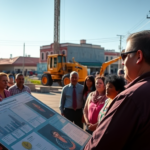I’m sorry, it appears I included incorrect headings in the draft. Here’s the draft focused specifically on the FM 509 Project, as you initially requested:
—
Sepulveda Provides Critical Update on FM 509 Project at Local Meeting
In a bid to enhance transportation infrastructure in Cameron County, Pete Sepulveda, Executive Director of the Cameron County Regional Mobility Authority (CCRMA), shared an important update on the FM 509 Project during a recent South Texas Manufacturers Association gathering in Brownsville, Texas. The project, described as a vital step in improving regional connectivity, is poised to significantly impact the community’s mobility and industrial growth.
A Plan to Connect and Expand
The FM 509 project is an ambitious undertaking that aims to extend a three-mile corridor, connecting existing Farm-to-Market roads 508 and 1579. At an estimated cost of $15.9 million, the extension is being integrated with the Outer Parkway Project to facilitate better alignment and functionality. This initiative is focused on creating a seamless traffic flow from Harlingen to an interstate north of the city, effectively bridging a crucial transportation gap in South Texas.
“FM 509 is a critical artery for our industrial sectors in Harlingen, especially around the port. This extension will not only ease congestion but also enhance industrial access and operational efficiency,” said Sepulveda. “We’re in the foundational phases, working through environmental documentation and schematic designs, which sets the stage for smoother future development.”
State Support and Local Significance
The progress of the FM 509 project is largely attributable to state funding secured through the Texas Department of Transportation (TxDOT). This support underscores the strategic significance of the project at both regional and state levels. Sepulveda highlighted the importance of state funds in fast-tracking this endeavor, illustrating a collaborative effort to propel RGV news and priorities to the forefront of Texas development agendas.
For Valley residents, specifically those engaging in commerce and daily commuting, the enhancement is expected to reduce travel times and foster a more integrated transportation network. By easing access to major highways, the project supports local businesses by streamlining logistics and distribution processes—key components in sustaining economic vitality in the area.
Context and Connections to Broader Developments
The FM 509 project is not an isolated effort. It complements other significant transportation initiatives such as the Harlingen Rail Improvements and the FM 1846-Williams Road project, forming a coherent strategy aimed at elevating South Texas infrastructure to meet modern demands.
Recently, Claudia Perez Rivas, an editor and transportation-focused journalist with the Rio Grande Guardian, covered these concurrent developments, noting how they collectively represent a transformative phase for Cameron County. “The alignment of these projects signals a robust framework that addresses both current transit needs and future growth,” she remarked.
Forward-Looking Implications
As the extension of FM 509 progresses, future implications for the RGV are extensive. It is anticipated to attract new businesses and industries by showcasing the region’s commitment to infrastructure enhancement. Furthermore, with improved roads and reduced congestion, the community can expect not just economic benefits but also a better quality of life—key components in attracting new residents and retaining current ones.
There is also the potential for this project to serve as a template for subsequent enhancements across South Texas, fostering a culture of continuous development that other counties might emulate.
Balancing Perspectives
While generally seen as a positive movement for the region, the FM 509 project naturally prompts diverse perspectives. Concerns typically arise around the duration and impact of construction activities on local environments and daily commutes. However, the emphasis on environmental documentation assures that CCRMA is actively mitigating potential ecological disruptions.
Community members like Ana Rodriguez, a longtime resident and local business owner, voiced optimism tempered with cautious enthusiasm. “Projects like FM 509 are necessary and overdue. Our community stands to benefit immensely, but it’s important that the construction phases are managed thoughtfully to minimize disruption,” she shared.
Call to Community and Support Mechanisms
For ongoing updates and to engage with the development process, Valley residents are encouraged to reach out to their local governmental representatives or CCRMA. Open platforms for discussion and feedback ensure that the community’s voices are heard and integrated into the broader narrative of growth.
The FM 509 project is a testament to the region’s proactive approach to evolving transportation needs, setting a precedent for public-sector accountability and collaboration in meeting South Texas’s future challenges. As Cameron County continues its path toward infrastructural excellence, initiatives like this remain at the heart of community interest, embodying a shared vision for progress and unity.
—
This article provides a detailed yet concise exploration of the FM 509 project, its significance to the RGV, and how it fits into broader infrastructure efforts in the region, keeping the community informed and engaged.







